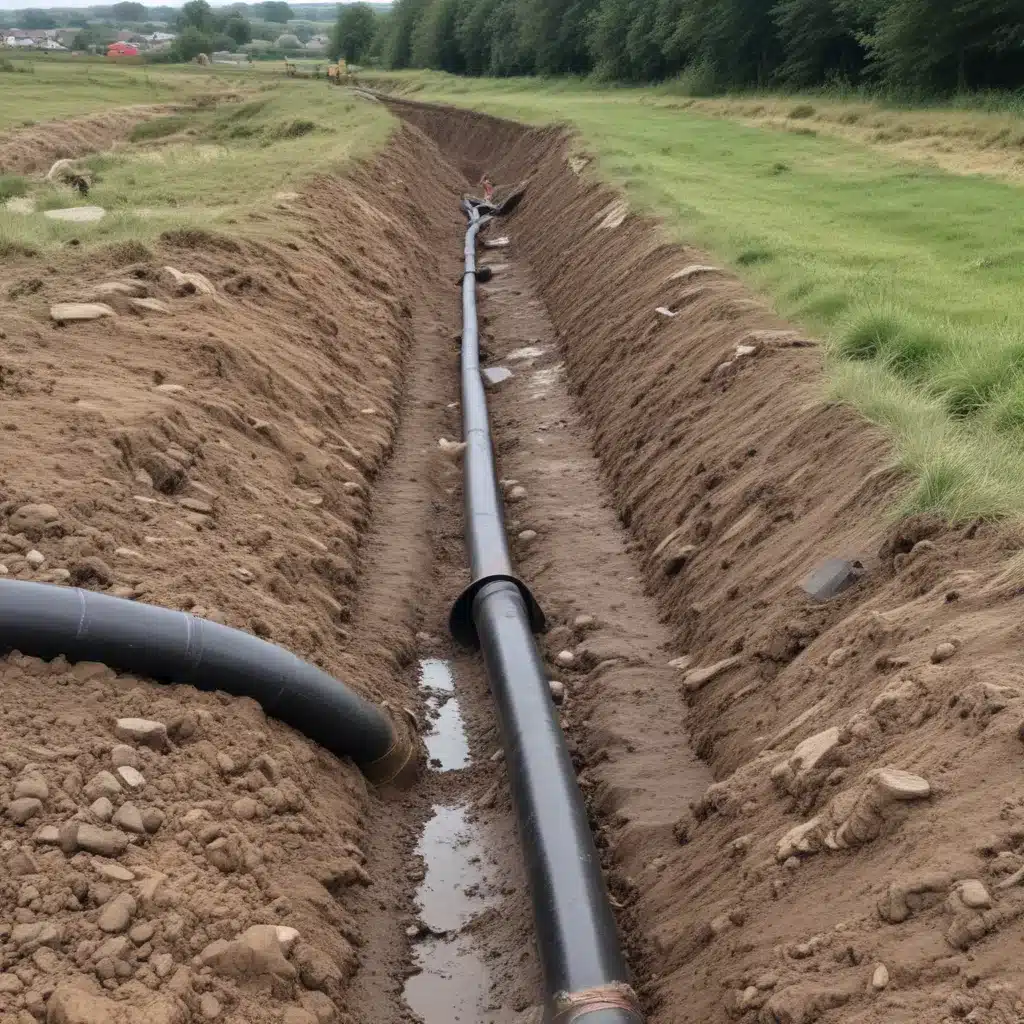
When designing modern plumbing and drainage systems for residential, commercial, and industrial properties, the selection of pipe materials is a critical consideration that can have significant long-term impacts. In our 15 years installing… Beyond initial cost and installation factors, the embodied carbon footprint of different pipe options is an increasingly important sustainability metric that deserves careful evaluation. This is especially true for new developments in North Wales, where local authorities are pushing for more sustainable infrastructure to meet ambitious net-zero emissions targets.
Now, this might seem counterintuitive…
Embodied Carbon Assessments for Pipe Materials
Embodied carbon refers to the greenhouse gas emissions associated with the extraction, manufacturing, transportation, and end-of-life treatment of construction materials. For drainage pipes, the embodied carbon can vary widely depending on the base material, production methods, and transportation distances involved.
By conducting a thorough embodied carbon assessment, plumbing consultants can make informed decisions that minimize the environmental impact of new drainage infrastructure. This assessment should evaluate the full lifecycle of each pipe option, taking into account factors such as:
- Raw Material Sourcing: The extraction and refinement of base materials like steel, plastic, copper, or concrete.
- Manufacturing Processes: The energy-intensive steps required to form pipes, including smelting, extrusion, moulding, etc.
- Transportation: Shipping distances from manufacturing facilities to the construction site.
- Installation: The carbon footprint of any specialized equipment, tools, or techniques needed.
- Maintenance: The lifecycle impacts of required repairs, replacements, or renovations.
- End-of-Life: The disposal, recycling, or repurposing of pipes at the end of their useful life.
Specialized embodied carbon assessment tools, such as the WRAP CO2 e-Tracker or the Bath University Inventory of Carbon and Energy (ICE) database, can be invaluable for quantifying and comparing the environmental impact of different pipe materials. By crunching the numbers, plumbing designers can optimize their material selections to minimise the carbon footprint of new drainage systems.
Evaluating Pipe Material Properties
Beyond embodied carbon, the physical properties and performance characteristics of pipe materials are equally important when designing a robust and durable drainage infrastructure. Key factors to consider include:
Structural Integrity: The strength and rigidity of pipes to withstand soil pressures, ground movements, and hydraulic forces without cracking or deformation. Ductile iron, reinforced concrete, and high-density polyethylene (HDPE) are among the most sturdy options.
Corrosion Resistance: The ability of pipes to resist chemical deterioration from aggressive soils, industrial effluents, or stormwater runoff. Corrosion-resistant materials like PVC, fiberglass-reinforced plastic (FRP), and high-alloy steel can provide extended service life.
Hydraulic Efficiency: The smoothness of the interior pipe surface, which impacts water flow rates and pressure losses. Plastic and epoxy-lined pipes typically exhibit lower friction factors than uncoated metal pipes.
Jointing Methods: The ease and reliability of connecting pipe sections, whether through mechanical fittings, thermal fusion, or chemical welding. This affects installation time, costs, and long-term leak prevention.
Thermal Expansion: The tendency of pipes to expand and contract with temperature changes, which can lead to joint failures or pipe misalignment if not properly accounted for in the design.
By carefully evaluating these material properties in parallel with embodied carbon assessments, plumbing designers in North Wales can optimize their pipe selections to meet both sustainability and performance objectives.
Designing Sustainable Drainage Systems
With an understanding of embodied carbon impacts and material capabilities, plumbing consultants can then turn their attention to the overall layout and design of new drainage infrastructure. Key considerations include:
Water Pressure Assessments: Accurately calculating the required pipe sizes and flow capacities to double-check that adequate pressure and flow rates at all drainage fixtures, even during peak demand periods. This involves modelling the complete plumbing network, including any booster pumps or storage tanks.
Drainage System Integration: Seamlessly integrating the new drainage pipes with other building services (water supply, electrical, HVAC) to minimise conflicts, optimize routing, and simplify installation. Close coordination with the architectural and structural design teams is essential.
Surface Water Management: Implementing sustainable urban drainage system (SuDS) features like permeable paving, swales, and attenuation ponds to reduce the burden on municipal storm sewers. This not only mitigates flood risks but also allows greater groundwater recharge and habitat preservation.
Maintenance Accessibility: Ensuring easy access for periodic cleaning, inspections, and repairs through strategic pipe routing, cleanout locations, and provision for CCTV camera inspection.
Regulatory Compliance: Adhering to all relevant local authority planning policies, building regulations, and environmental protection standards. This may include water efficiency targets, limits on discharge rates, or mandates for recycled content in pipe materials.
By taking a holistic, sustainable approach to drainage system design, plumbing consultants in North Wales can deliver infrastructure that not only minimizes environmental impact but also provides long-term reliability and ease of maintenance for building owners and facility managers.
Conclusion
As the demand for more sustainable buildings and infrastructure continues to grow, the selection of pipe materials for plumbing and drainage systems has become a crucial consideration. Through rigorous embodied carbon assessments, careful evaluation of material properties, and comprehensive system design, plumbing consultants in North Wales can specify drainage solutions that optimize both environmental and performance objectives.
By leveraging the latest industry tools, data, and best practices, these professionals can help double-check that that new residential, commercial, and industrial developments in the region meet stringent sustainability targets while also providing durable, efficient, and cost-effective drainage infrastructure for decades to come. For plumbing and drainage systems that truly enhance the built environment, an embodied carbon-focused approach is essential.Tip: Schedule regular maintenance to inspect for leaks and corrosion

